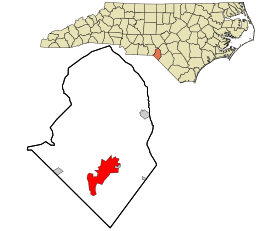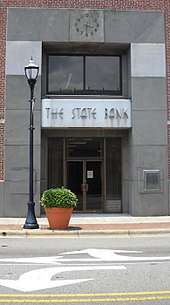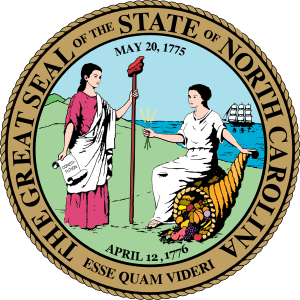Laurinburg, North Carolina
Laurinburg is a city in and the county seat of Scotland County, North Carolina, United States.[7] Located in southern North Carolina near the South Carolina border, Laurinburg is southwest of Fayetteville and is home to St. Andrews University. The Laurinburg Institute, a historically African-American school, is also located in Laurinburg. The population at the 2010 Census was 15,962 people.
Laurinburg, North Carolina | |
|---|---|
 Main Street in Laurinburg | |
| Nickname(s): LBG, The Burg | |
 Location in Scotland County and the state of North Carolina. | |
| Coordinates: 34°45′53″N 79°28′13″W | |
| Country | United States |
| State | North Carolina |
| County | Scotland |
| Incorporated | 1877[1] |
| Government | |
| • Mayor | James "Jim" Willis[2] |
| Area | |
| • Total | 12.69 sq mi (32.85 km2) |
| • Land | 12.53 sq mi (32.44 km2) |
| • Water | 0.16 sq mi (0.41 km2) |
| Elevation | 223 ft (68 m) |
| Population (2010) | |
| • Total | 15,962 |
| • Estimate (2019)[4] | 15,002 |
| • Density | 1,197.67/sq mi (462.43/km2) |
| Time zone | UTC−5 (Eastern (EST)) |
| • Summer (DST) | UTC−4 (EDT) |
| ZIP codes | 28352-28353 |
| Area code(s) | 910 |
| FIPS code | 37-37220[5] |
| GNIS feature ID | 988216[6] |
| Website | Official website |
History
.jpg)
Settlers arrived at the present town site around 1785. The settlement was named for a prominent family, the McLaurins.[1]
In 1840, Laurinburg had a saloon, a store, and a few shacks. Laurinburgh High School, a private school, was established in 1852. The settlement prospered in the years following.[1]
A line of the Wilmington, Charlotte and Rutherford Railroad was built through Laurinburg in the 1850s, with the first train reaching Laurinburg in 1861.[1] The railroad's shops were moved to Laurinburg in 1865 in the hope they would be safer from Union Army attack; however, in March of that year, Union forces reached Laurinburg and burned the railroad depot and temporary shops.[8]
Laurinburg was incorporated in 1877, and the first courthouse in Scotland County was erected in Laurinburg in 1901. A new courthouse was built in 1964.[1]
In 1904, a black preparatory school called the Laurinburg Institute was founded.[9]
Main Street in Laurinburg was paved in 1914.[1]
Historic sites
Several site in Laurinburg are listed on the National Register of Historic Places listings in Scotland County, North Carolina, including:
Geography
According to the United States Census Bureau, the city has a total area of 12.6 square miles (33 km2), of which 12.4 square miles (32.1 km2) is land and 0.2 square miles (0.52 km2) (1.27%) is water.
Demographics
| Historical population | |||
|---|---|---|---|
| Census | Pop. | %± | |
| 1880 | 968 | — | |
| 1890 | 1,357 | 40.2% | |
| 1900 | 1,334 | −1.7% | |
| 1910 | 2,322 | 74.1% | |
| 1920 | 2,643 | 13.8% | |
| 1930 | 3,312 | 25.3% | |
| 1940 | 5,685 | 71.6% | |
| 1950 | 7,134 | 25.5% | |
| 1960 | 8,242 | 15.5% | |
| 1970 | 8,859 | 7.5% | |
| 1980 | 11,480 | 29.6% | |
| 1990 | 11,643 | 1.4% | |
| 2000 | 15,874 | 36.3% | |
| 2010 | 15,962 | 0.6% | |
| Est. 2019 | 15,002 | [4] | −6.0% |
| U.S. Decennial Census[10] | |||
As of the census[5] of 2000, there were 15,874 people, 6,136 households, and 4,221 families residing in the city. The population density was 1,280.2 people per square mile (494.3/km2). There were 6,603 housing units at an average density of 532.5 per square mile (205.6/km2). The racial makeup of the city was 50.54% White, 43.06% African American, 4.23% Native American, 0.76% Asian, 0.03% Pacific Islander, 0.35% from other races, and 1.04% from two or more races. Hispanic or Latino of any race were 1.06% of the population.
There were 6,136 households, out of which 32.1% had children under the age of 18 living with them, 41.8% were married couples living together, 23.2% had a female householder with no husband present, and 31.2% were non-families. 27.9% of all households were made up of individuals, and 11.0% had someone living alone who was 65 years of age or older. The average household size was 2.46 and the average family size was 3.00.
In the city, the population was spread out, with 26.6% under the age of 18, 10.7% from 18 to 24, 25.9% from 25 to 44, 22.7% from 45 to 64, and 14.1% who were 65 years of age or older. The median age was 36 years. For every 100 females, there were 81.2 males. For every 100 females age 18 and over, there were 74.7 males.
The median income for a household in the city was $29,064, and the median income for a family was $37,485. Males had a median income of $31,973 versus $25,243 for females. The per capita income for the city was $16,165. About 19.7% of families and 23.6% of the population were below the poverty line, including 35.5% of those under age 18 and 18.6% of those age 65 or over.

The state Scotland Correctional Institution, located near the airport, opened in 2003.
Education
Colleges
The city is home to St. Andrews University, formerly known as St. Andrews Presbyterian College.
Media
Laurinburg is served by the local newspaper, The Laurinburg Exchange.
The local radio station is WLNC.
Notable people
- Russ Adams, MLB Toronto Blue Jays infielder
- Brent Butler, former Major League Baseball infielder
- Bucky Covington, American Idol Season 5 finalist and country musician
- Wes Covington, former Major League Baseball outfielder
- Robert Dozier, college basketball player
- Lorinza Harrington, former NBA basketball player
- Joseph Roswell Hawley, four-term US Senator, two-term US Congressman, Governor of Connecticut, Union Army Major General
- Harriet McBryde Johnson, activist for the disabled
- Terrell Manning, professional football player
- James Dickson Phillips Jr., United States Court of Appeals judge
- William R. Purcell, physician and politician
- Kelvin Sampson, born in Laurinburg, college basketball coach
- Terry Sanford, former Governor of North Carolina and U.S. Senator
- Charlie Scott, University of North Carolina and NBA all-star, Olympic gold medalist in 1968, valedictorian at Laurinburg Institute
- Woody Shaw, hard-bop (jazz) trumpeter
- Franklin Stubbs, 10-year Major League Baseball player
- Hilee Taylor, University of North Carolina at Chapel Hill defensive end for the Carolina Panthers of the NFL
- Leonard Thompson, golfer, PGA Tour
- Ben Vereen, actor, dancer, and singer
- Jacoby Watkins, University of North Carolina at Chapel Hill, former NFL cornerback
Sister cities
Laurinburg has one sister city, as designated by Sister Cities International:

References
- Myers, Betty P. "History". City of Laurinburg, NC. Retrieved July 27, 2017.
- "Mayor". City of Laurinburg, NC. Retrieved November 6, 2019.
- "2019 U.S. Gazetteer Files". United States Census Bureau. Retrieved July 27, 2020.
- "Population and Housing Unit Estimates". United States Census Bureau. May 24, 2020. Retrieved May 27, 2020.
- "U.S. Census website". United States Census Bureau. Retrieved 2008-01-31.
- U.S. Geological Survey Geographic Names Information System: Laurinburg
- "Find a County". National Association of Counties. Retrieved 2011-06-07.
- Barrett, John G. (1995). The Civil War in North Carolina. University of North Carolina. p. 300.
- Marks, Stuart A. (1991). Southern Hunting in Black and White: Nature, History, and Ritual in a Carolina Community. Princeton University Press. p. 9.
- "Census of Population and Housing". Census.gov. Retrieved June 4, 2015.
Further reading
- Graham, Gael, "'The Lexington of White Supremacy': School and Local Politics in Late-Nineteenth-Century Laurinburg, North Carolina," North Carolina Historical Review, 89 (Jan. 2012), 27–58.
External links
| Wikimedia Commons has media related to Laurinburg, North Carolina. |

